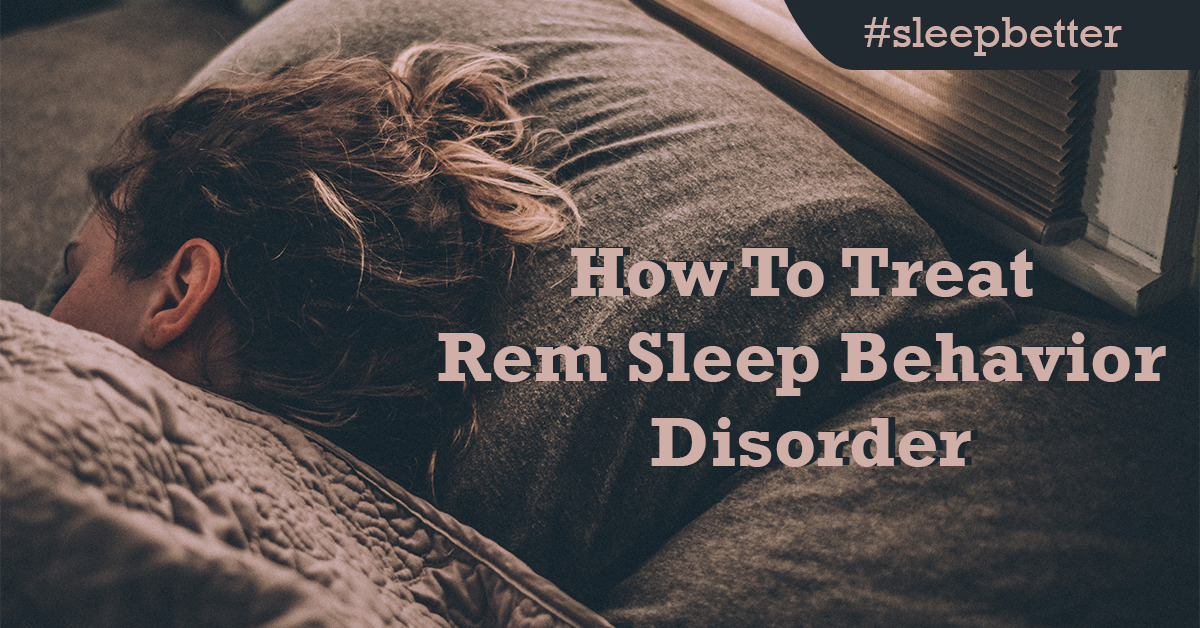How To Treat Rem Sleep Behavior Disorder

How To Treat Rem Sleep Behavior Disorder: The majority of the body’s muscles temporarily paralyze when the brain is awake and dreaming during REM sleep, as is normal. This enables us to dream peacefully and securely all night long. For people with REM sleep behavior disorder, the REM state does not involve paralysis. Instead, individuals continue to sleep as their bodies and voice act out their dreams. EnoughInfo.com

REM sleep behavior disorder is thought to affect less than 1% of persons. The disease, which typically manifests beyond the age of 50, is linked to other neurodegenerative conditions such as Parkinson’s disease, Lewy body dementia, and multiple system atrophy. With time, symptoms frequently get worse. Because the condition increases the risk of harm to oneself and one’s bed partner, treatment is usually necessary.
What is Rem’s sleep behavior disorder?
REM sleep behavior disorder (RBD) is a sleep disorder that causes people to act out their dreams during REM sleep, which is typically a time of muscle paralysis. Unlike most people who experience REM sleep, those with RBD are able to move and can act out vivid and sometimes violent dreams. This can result in injury to themselves or their sleep partners. RBD is considered a type of parasomnia, which is a category of sleep disorders that involve abnormal behaviors or experiences during sleep. How To Keep Cilantro Fresh( The Ultimate Guide)
RBD is most commonly seen in men over the age of 50, but can occur in anyone at any age. It is important to seek medical attention if you suspect you or a loved one may be experiencing RBD, as it can be a symptom of an underlying neurological condition.
FAQs & Answers On How To Treat Rem Sleep Behavior Disorder
1, Is REM sleep behavior disorder a mental illness?
2, How terrible is REM behavior disorder?
Rapid eye movement behavior disorder (RBD) is a parasomnia characterized by dream enactment behavior and atonic atrophy during REM sleep. The person experiencing these symptoms as well as their bed companions could suffer catastrophic consequences.
3, How do those who have REM sleep behavior disorder behave?
REM sleep behavior disorder symptoms could include: Movement in response to action-packed or violent nightmares, such as being chased or defending yourself from an attack, including kicking, punching, flailing the arms, or jumping out of bed. Talking, laughing, shouting, sobbing, or even cursing are examples of sounds.
4, Who does REM sleep behavior disorder affect?
REM sleep behavior disorder (RBD) can affect anyone at any age, but it is most commonly seen in men over the age of 50. Some studies have suggested that RBD may be more common in people with certain neurological conditions such as Parkinson’s disease, multiple system atrophy, and Lewy body dementia. It can also be a side effect of certain medications, such as antidepressants and antipsychotics. RBD can occur in isolation or as a symptom of an underlying neurological disorder, and it is important to seek medical attention if you suspect you or a loved one may be experiencing RBD. How To Clean Suede Shoes(The Ultimate Guide)
Read Also: 185+ Deep Love Messages For Her (Melt Her Heart)
Symptoms of REM sleep behavior disorder
Symptoms of REM sleep behavior disorder include:
- the limbs only move periodically
- Punching, thrashing, kicking, sitting up in bed, or leaping out of bed are more pronounced bodily motions.
- Screaming, shouting, and other vocalizations
People aren’t conscious of these behaviors while they are occurring, and many people don’t even realize they have REM sleep behavior disorder until their bed partner or flatmate mentions their symptoms to them. People who are experiencing an episode are typically fairly easy to wake up. They typically remember the details of their dreams when they wake up and are attentive and coherent.
The first stages of REM sleep typically start about 90 minutes after you go to sleep, and they lengthen throughout the second half of the night. Because of this, REM sleep behavior disorder episodes usually start later in a sleep cycle. Episodes can happen just once or several times during the night. They might happen to people occasionally or every night. Although the symptoms of REM sleep behavior disorder can appear suddenly or gradually, they usually get worse over time.
Risk factors
REM sleep disorders are at risk for:
- Being male
- To be older than 50
- Being affected by another neurological condition, such as Parkinson’s disease, Lewy body dementia, or multiple system atrophy
- A narcoleptic
- Antidepressant or pharmaceutical use
- Alcohol or drug abuse or abstinence
In 87 percent of cases, men, the average age of onset is 61 years old. Understanding the environmental causes of REM sleep behavior disorder requires additional investigation. Environmental risk factors may include sleep deprivation, smoking, concussions, and pesticide exposure.
Complication
People with REM sleep behavior disorder may endanger themselves and their bed partner due to the potentially aggressive nature of their movements. Additionally, it may frequently interrupt your sleep, which may reduce the overall quality of your slumber.
Injury types include:
- Bruises.
- Cuts.
- Sprains.
- Bone fractures.
- Damage to the head and subdural hematomas.
These injuries can occasionally pose a threat to life.Up to 90% of partners of those who have RBD struggle with sleep. More than 60% had been hurt physically. As a result, it’s critical to get treatment for RBD, or at the absolute least, make your bedroom a safer place to sleep. How To Create NFT On Opensea( All You Need To Know)
How To Treat Rem Sleep Behavior Disorder
REM sleep behavior disorder (RBD) is a sleep disorder that can cause a person to physically act out their dreams during REM (rapid eye movement) sleep. This can result in injuries to the person and their sleep partner. RBD can be treated through a combination of medication, lifestyle changes, safety measures, cognitive-behavioral therapy (CBT), and treating underlying conditions.
Lifestyle Changes
Certain lifestyle changes can also help to reduce the risk of RBD. Establishing a regular sleep routine and practicing good sleep hygiene can help to promote restful sleep and reduce the occurrence of RBD. This includes avoiding caffeine and alcohol before bed, creating a quiet and comfortable sleep environment, and reducing stress levels through relaxation techniques such as meditation or yoga.
Medications
Medications such as clonazepam and melatonin are commonly prescribed to suppress the activity of the nervous system during sleep, which can help to reduce or eliminate the disruptive behaviors associated with RBD. Clonazepam is a type of benzodiazepine that has been shown to be effective in reducing RBD symptoms in many patients. Melatonin, a hormone that regulates the sleep-wake cycle, can also be used to reduce the frequency and severity of RBD episodes.
Treating Underlying Conditions
RBD can sometimes be a symptom of an underlying condition such as Parkinson’s disease or dementia. Treating the underlying condition may also help to reduce RBD symptoms. In cases where RBD is caused by a medication or substance, the person may need to switch to a different medication or stop using the substance to alleviate their symptoms. How To Cure Hemolytic Uremic Syndrome(2023 Guide)
Safety Measures On How To Treat Rem Sleep Behavior Disorder
Since RBD can cause violent movements during sleep, it is essential to take precautions to prevent injuries. This includes using soft bedding, padding sharp edges in the bedroom, and avoiding sleeping on elevated surfaces such as bunk beds or waterbeds. Some people with RBD may also benefit from wearing protective padding on their limbs or using bed rails to prevent falls.
Cognitive-Behavioral Therapy (CBT)
CBT is a type of therapy that can help to identify and change negative thoughts and behaviors related to sleep. This may include relaxation techniques, such as deep breathing or muscle relaxation, as well as cognitive restructuring to address negative thoughts or fears related to sleep. CBT can be particularly helpful for people with RBD who have anxiety or stress-related symptoms that contribute to their sleep disorder.
Conclusion
In conclusion, treating REM sleep behavior disorder (RBD) involves a combination of medications, lifestyle changes, safety measures, cognitive-behavioral therapy, and treating underlying conditions. By working with a healthcare provider to determine the best treatment plan for their individual needs, people with RBD can achieve restful sleep and reduce the risk of complications associated with this disorder. With proper treatment, RBD no longer has to be a disruptive and distressing condition that interferes with daily life, but rather a manageable disorder that allows for a restful and safe night’s sleep. How To Identify Market Trends Using Price Charts And Indicators
Recommended:
How To Cure Hemolytic Uremic Syndrome(2023 Guide)
Healthy Aging Tips For Men Over 40 (14 Tips To Stay Healthy)
How Do You Treat And Cure Amyloidosis Naturally




